
Question Number 181055 by Acem last updated on 21/Nov/22

Commented by Acem last updated on 21/Nov/22

$$\ast\:{DABC} \\ $$$${Please},\:{the}\:{comments}\:{section}\:{is}\:{only} \\ $$$$\:\:\:\:\:\:\:\:\:\:\:\:\:\:\:\:\:\:\:\:\:\:\:\:\:\:\:\:\:\:\:\:\:{for} \\ $$$$\:\:\:\:\:\boldsymbol{{inquiries}}\:\boldsymbol{{and}}\:\boldsymbol{{clarifications}} \\ $$$$ \\ $$
Commented by som(math1967) last updated on 21/Nov/22

Commented by som(math1967) last updated on 21/Nov/22
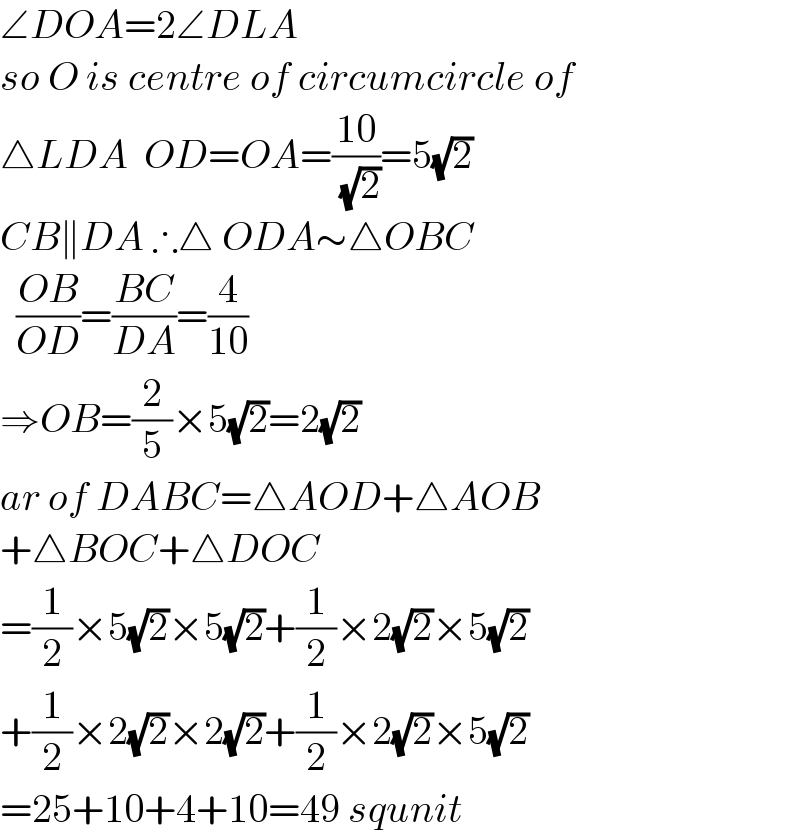
$$\angle{DOA}=\mathrm{2}\angle{DLA} \\ $$$${so}\:{O}\:{is}\:{centre}\:{of}\:{circumcircle}\:{of} \\ $$$$\bigtriangleup{LDA}\:\:{OD}={OA}=\frac{\mathrm{10}}{\:\sqrt{\mathrm{2}}}=\mathrm{5}\sqrt{\mathrm{2}} \\ $$$${CB}\parallel{DA}\:\therefore\bigtriangleup\:{ODA}\sim\bigtriangleup{OBC} \\ $$$$\:\:\frac{{OB}}{{OD}}=\frac{{BC}}{{DA}}=\frac{\mathrm{4}}{\mathrm{10}} \\ $$$$\Rightarrow{OB}=\frac{\mathrm{2}}{\mathrm{5}}×\mathrm{5}\sqrt{\mathrm{2}}=\mathrm{2}\sqrt{\mathrm{2}} \\ $$$${ar}\:{of}\:{DABC}=\bigtriangleup{AOD}+\bigtriangleup{AOB} \\ $$$$+\bigtriangleup{BOC}+\bigtriangleup{DOC} \\ $$$$=\frac{\mathrm{1}}{\mathrm{2}}×\mathrm{5}\sqrt{\mathrm{2}}×\mathrm{5}\sqrt{\mathrm{2}}+\frac{\mathrm{1}}{\mathrm{2}}×\mathrm{2}\sqrt{\mathrm{2}}×\mathrm{5}\sqrt{\mathrm{2}} \\ $$$$+\frac{\mathrm{1}}{\mathrm{2}}×\mathrm{2}\sqrt{\mathrm{2}}×\mathrm{2}\sqrt{\mathrm{2}}+\frac{\mathrm{1}}{\mathrm{2}}×\mathrm{2}\sqrt{\mathrm{2}}×\mathrm{5}\sqrt{\mathrm{2}} \\ $$$$=\mathrm{25}+\mathrm{10}+\mathrm{4}+\mathrm{10}=\mathrm{49}\:{squnit} \\ $$
Commented by mr W last updated on 21/Nov/22
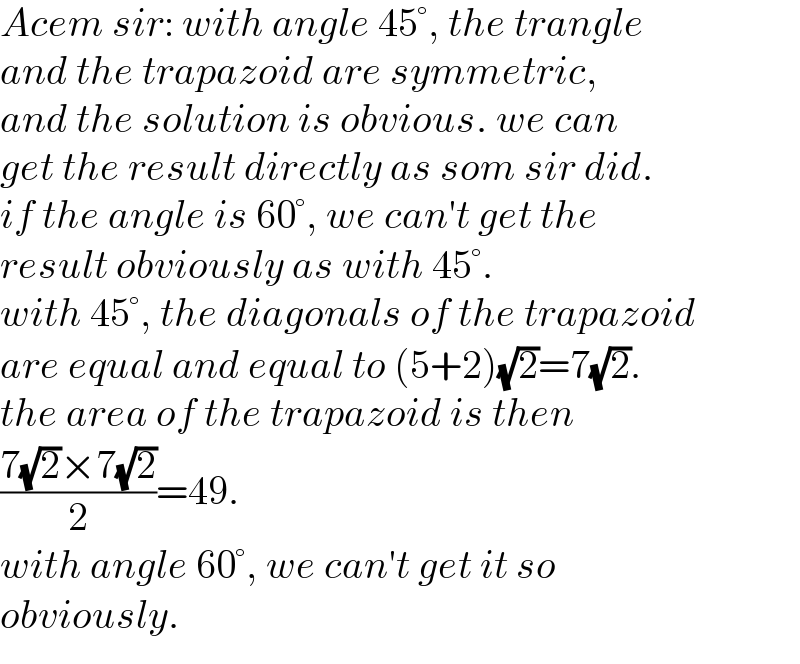
$${Acem}\:{sir}:\:{with}\:{angle}\:\mathrm{45}°,\:{the}\:{trangle} \\ $$$${and}\:{the}\:{trapazoid}\:{are}\:{symmetric}, \\ $$$${and}\:{the}\:{solution}\:{is}\:{obvious}.\:{we}\:{can} \\ $$$${get}\:{the}\:{result}\:{directly}\:{as}\:{som}\:{sir}\:{did}. \\ $$$${if}\:{the}\:{angle}\:{is}\:\mathrm{60}°,\:{we}\:{can}'{t}\:{get}\:{the} \\ $$$${result}\:{obviously}\:{as}\:{with}\:\mathrm{45}°. \\ $$$${with}\:\mathrm{45}°,\:{the}\:{diagonals}\:{of}\:{the}\:{trapazoid} \\ $$$${are}\:{equal}\:{and}\:{equal}\:{to}\:\left(\mathrm{5}+\mathrm{2}\right)\sqrt{\mathrm{2}}=\mathrm{7}\sqrt{\mathrm{2}}. \\ $$$${the}\:{area}\:{of}\:{the}\:{trapazoid}\:{is}\:{then} \\ $$$$\frac{\mathrm{7}\sqrt{\mathrm{2}}×\mathrm{7}\sqrt{\mathrm{2}}}{\mathrm{2}}=\mathrm{49}. \\ $$$${with}\:{angle}\:\mathrm{60}°,\:{we}\:{can}'{t}\:{get}\:{it}\:{so} \\ $$$${obviously}. \\ $$
Commented by Acem last updated on 21/Nov/22
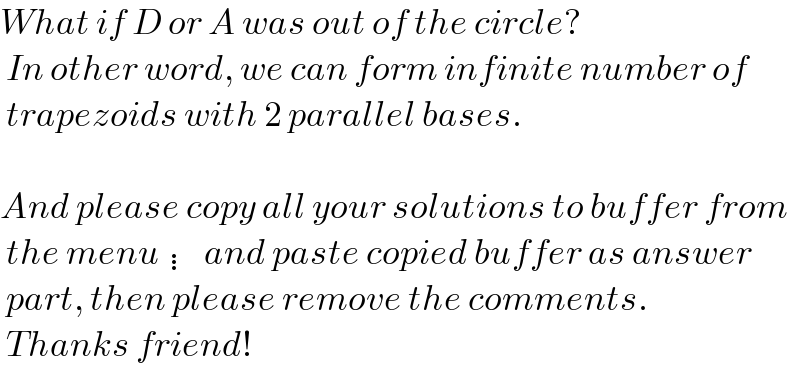
$${What}\:{if}\:{D}\:{or}\:{A}\:{was}\:{out}\:{of}\:{the}\:{circle}? \\ $$$$\:{In}\:{other}\:{word},\:{we}\:{can}\:{form}\:{infinite}\:{number}\:{of}\: \\ $$$$\:{trapezoids}\:{with}\:\mathrm{2}\:{parallel}\:{bases}. \\ $$$$ \\ $$$${And}\:{please}\:{copy}\:{all}\:{your}\:{solutions}\:{to}\:{buffer}\:{from} \\ $$$$\:{the}\:{menu}\:\vdots{and}\:{paste}\:{copied}\:{buffer}\:{as}\:{answer} \\ $$$$\:{part},\:{then}\:{please}\:{remove}\:{the}\:{comments}. \\ $$$$\:{Thanks}\:{friend}! \\ $$
Commented by mr W last updated on 21/Nov/22

$${the}\:{angle}\:\mathrm{45}°\:{makes}\:{the}\:{thing}\:{to}\:{a} \\ $$$${special}\:{case}\:{which}\:{is}\:{too}\:{obvious}.\: \\ $$$${it}'{s}\:{more}\:{interesting}\:{when}\:{the}\:{angle} \\ $$$${is}\:{not}\:\mathrm{45}°,\:{but}\:{e}.{g}.\:\mathrm{60}°. \\ $$
Commented by mr W last updated on 21/Nov/22

$${the}\:{solution}\:{above}\:{from}\:{som}\:{sir}\:{is}\: \\ $$$${wonderful}! \\ $$
Commented by Acem last updated on 21/Nov/22

$${No}\:{problem}\:{Sir}\:{Som} \\ $$
Commented by Acem last updated on 21/Nov/22

$${With}\:{an}\:{angle}\:\mathrm{45}\:{is}\:{more}\:{interesting}\:{than}\:\mathrm{60} \\ $$$$ \\ $$
Commented by som(math1967) last updated on 21/Nov/22

$${sorry}\:{cannot}\:{load}\:{as}\:{answer}\: \\ $$
Commented by MJS_new last updated on 21/Nov/22

$$\mathrm{they}\:\mathrm{are}\:{not}\:\mathrm{symmetric}\:\mathrm{in}\:\mathrm{my}\:\mathrm{opinion}.\:\mathrm{the} \\ $$$$\mathrm{angle}\:\mathrm{in}\:\mathrm{the}\:\mathrm{center}\:\mathrm{is}\:\mathrm{marked}\:\mathrm{as}\:\mathrm{90}° \\ $$
Commented by mr W last updated on 21/Nov/22

$${yes}.\:{now}\:{i}\:{see}.\:{it}\:{mustn}'{t}\:{be}\:{symmetric} \\ $$$${with}\:\mathrm{45}°. \\ $$
Commented by MJS_new last updated on 21/Nov/22
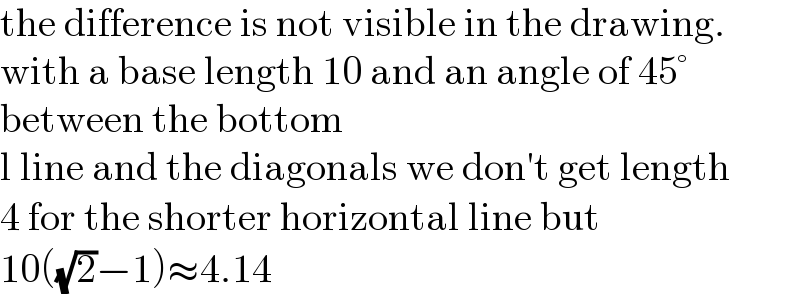
$$\mathrm{the}\:\mathrm{difference}\:\mathrm{is}\:\mathrm{not}\:\mathrm{visible}\:\mathrm{in}\:\mathrm{the}\:\mathrm{drawing}. \\ $$$$\mathrm{with}\:\mathrm{a}\:\mathrm{base}\:\mathrm{length}\:\mathrm{10}\:\mathrm{and}\:\mathrm{an}\:\mathrm{angle}\:\mathrm{of}\:\mathrm{45}° \\ $$$$\mathrm{between}\:\mathrm{the}\:\mathrm{bottom} \\ $$$$\mathrm{l}\:\mathrm{line}\:\mathrm{and}\:\mathrm{the}\:\mathrm{diagonals}\:\mathrm{we}\:\mathrm{don}'\mathrm{t}\:\mathrm{get}\:\mathrm{length} \\ $$$$\mathrm{4}\:\mathrm{for}\:\mathrm{the}\:\mathrm{shorter}\:\mathrm{horizontal}\:\mathrm{line}\:\mathrm{but} \\ $$$$\mathrm{10}\left(\sqrt{\mathrm{2}}−\mathrm{1}\right)\approx\mathrm{4}.\mathrm{14} \\ $$
Commented by mr W last updated on 21/Nov/22

$${yes}\:{sir}!\:{i}\:{saw}\:{this}\:{contradiction}\:{very} \\ $$$${late}.\:\:{i}\:{think},\:{it}\:{is}\:{symmetric}\:{only} \\ $$$${when}\:\theta=\mathrm{46}.\mathrm{397}°. \\ $$
Answered by MJS_new last updated on 21/Nov/22
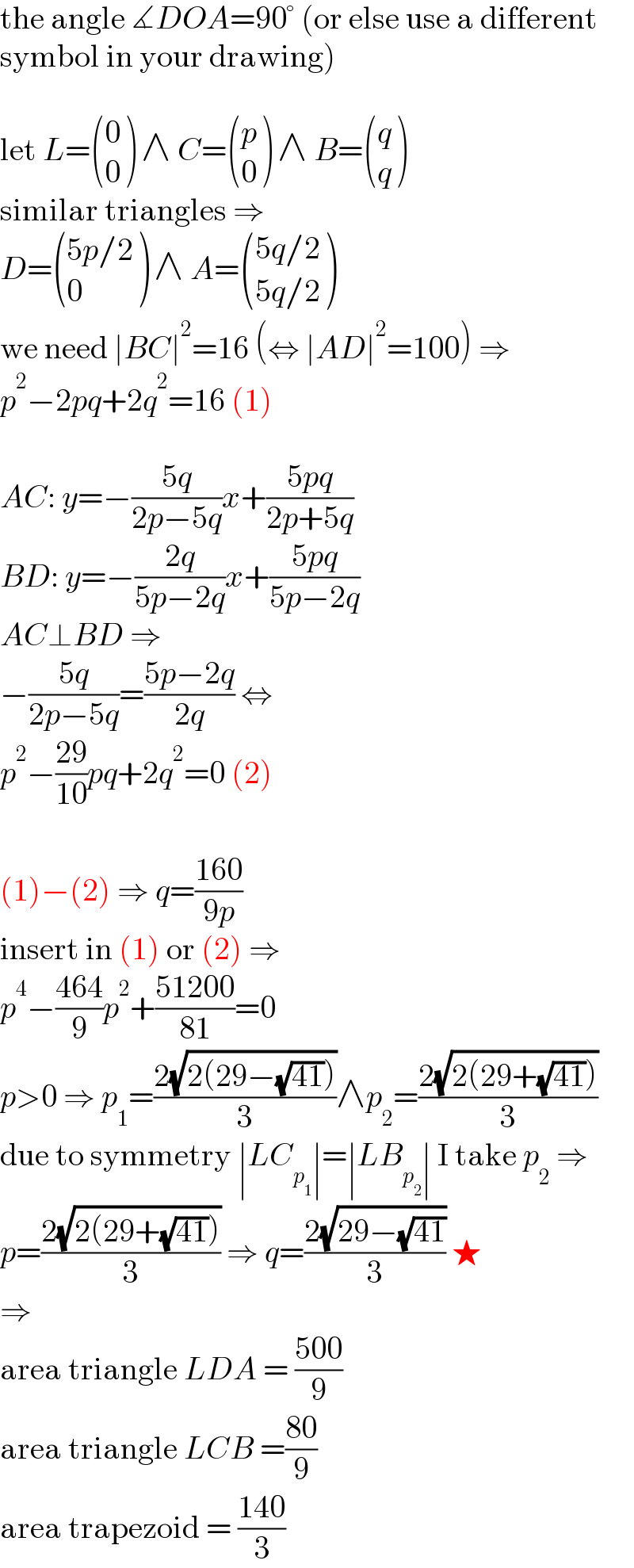
$$\mathrm{the}\:\mathrm{angle}\:\measuredangle{DOA}=\mathrm{90}°\:\left(\mathrm{or}\:\mathrm{else}\:\mathrm{use}\:\mathrm{a}\:\mathrm{different}\right. \\ $$$$\left.\mathrm{symbol}\:\mathrm{in}\:\mathrm{your}\:\mathrm{drawing}\right) \\ $$$$ \\ $$$$\mathrm{let}\:{L}=\begin{pmatrix}{\mathrm{0}}\\{\mathrm{0}}\end{pmatrix}\:\wedge\:{C}=\begin{pmatrix}{{p}}\\{\mathrm{0}}\end{pmatrix}\:\wedge\:{B}=\begin{pmatrix}{{q}}\\{{q}}\end{pmatrix} \\ $$$$\mathrm{similar}\:\mathrm{triangles}\:\Rightarrow \\ $$$${D}=\begin{pmatrix}{\mathrm{5}{p}/\mathrm{2}}\\{\mathrm{0}}\end{pmatrix}\:\wedge\:{A}=\begin{pmatrix}{\mathrm{5}{q}/\mathrm{2}}\\{\mathrm{5}{q}/\mathrm{2}}\end{pmatrix} \\ $$$$\mathrm{we}\:\mathrm{need}\:\mid{BC}\mid^{\mathrm{2}} =\mathrm{16}\:\left(\Leftrightarrow\:\mid{AD}\mid^{\mathrm{2}} =\mathrm{100}\right)\:\Rightarrow \\ $$$${p}^{\mathrm{2}} −\mathrm{2}{pq}+\mathrm{2}{q}^{\mathrm{2}} =\mathrm{16}\:\left(\mathrm{1}\right) \\ $$$$ \\ $$$${AC}:\:{y}=−\frac{\mathrm{5}{q}}{\mathrm{2}{p}−\mathrm{5}{q}}{x}+\frac{\mathrm{5}{pq}}{\mathrm{2}{p}+\mathrm{5}{q}} \\ $$$${BD}:\:{y}=−\frac{\mathrm{2}{q}}{\mathrm{5}{p}−\mathrm{2}{q}}{x}+\frac{\mathrm{5}{pq}}{\mathrm{5}{p}−\mathrm{2}{q}} \\ $$$${AC}\bot{BD}\:\Rightarrow \\ $$$$−\frac{\mathrm{5}{q}}{\mathrm{2}{p}−\mathrm{5}{q}}=\frac{\mathrm{5}{p}−\mathrm{2}{q}}{\mathrm{2}{q}}\:\Leftrightarrow \\ $$$${p}^{\mathrm{2}} −\frac{\mathrm{29}}{\mathrm{10}}{pq}+\mathrm{2}{q}^{\mathrm{2}} =\mathrm{0}\:\left(\mathrm{2}\right) \\ $$$$ \\ $$$$\left(\mathrm{1}\right)−\left(\mathrm{2}\right)\:\Rightarrow\:{q}=\frac{\mathrm{160}}{\mathrm{9}{p}} \\ $$$$\mathrm{insert}\:\mathrm{in}\:\left(\mathrm{1}\right)\:\mathrm{or}\:\left(\mathrm{2}\right)\:\Rightarrow \\ $$$${p}^{\mathrm{4}} −\frac{\mathrm{464}}{\mathrm{9}}{p}^{\mathrm{2}} +\frac{\mathrm{51200}}{\mathrm{81}}=\mathrm{0} \\ $$$${p}>\mathrm{0}\:\Rightarrow\:{p}_{\mathrm{1}} =\frac{\mathrm{2}\sqrt{\mathrm{2}\left(\mathrm{29}−\sqrt{\mathrm{41}}\right)}}{\mathrm{3}}\wedge{p}_{\mathrm{2}} =\frac{\mathrm{2}\sqrt{\mathrm{2}\left(\mathrm{29}+\sqrt{\mathrm{41}}\right)}}{\mathrm{3}} \\ $$$$\mathrm{due}\:\mathrm{to}\:\mathrm{symmetry}\:\mid{LC}_{{p}_{\mathrm{1}} } \mid=\mid{LB}_{{p}_{\mathrm{2}} } \mid\:\mathrm{I}\:\mathrm{take}\:{p}_{\mathrm{2}} \:\Rightarrow \\ $$$${p}=\frac{\mathrm{2}\sqrt{\mathrm{2}\left(\mathrm{29}+\sqrt{\mathrm{41}}\right)}}{\mathrm{3}}\:\Rightarrow\:{q}=\frac{\mathrm{2}\sqrt{\mathrm{29}−\sqrt{\mathrm{41}}}}{\mathrm{3}}\:\bigstar \\ $$$$\Rightarrow \\ $$$$\mathrm{area}\:\mathrm{triangle}\:{LDA}\:=\:\frac{\mathrm{500}}{\mathrm{9}} \\ $$$$\mathrm{area}\:\mathrm{triangle}\:{LCB}\:=\frac{\mathrm{80}}{\mathrm{9}} \\ $$$$\mathrm{area}\:\mathrm{trapezoid}\:=\:\frac{\mathrm{140}}{\mathrm{3}} \\ $$
Commented by Acem last updated on 21/Nov/22

$${Very}\:{well}\:{work}\:{Sir}! \\ $$$$\:{You}\:{can}\:{check}\:{the}\:{other}\:{method}\:{bellow} \\ $$$${Thanks}! \\ $$
Answered by Acem last updated on 21/Nov/22

Commented by Acem last updated on 21/Nov/22
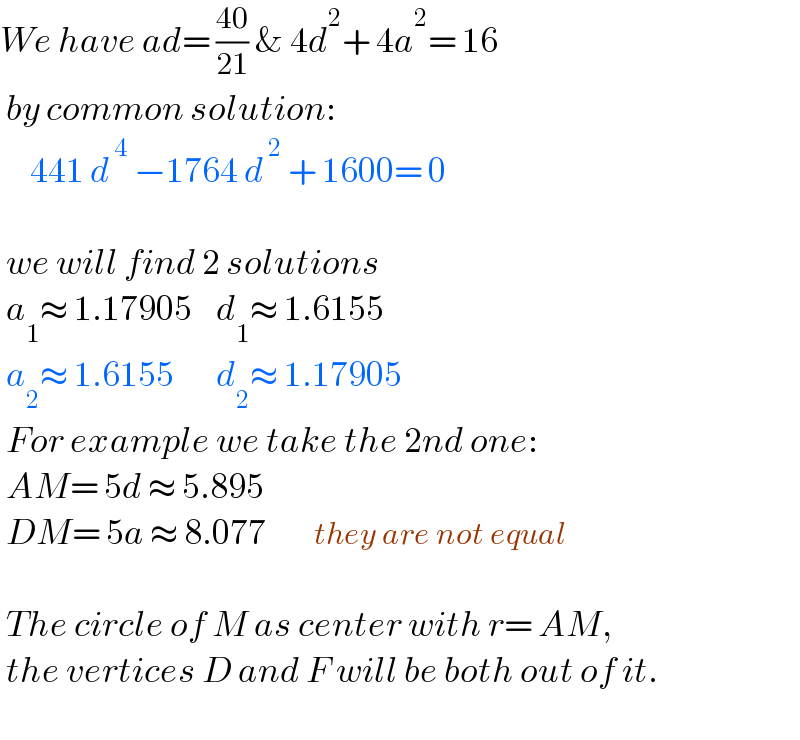
$${We}\:{have}\:{ad}=\:\frac{\mathrm{40}}{\mathrm{21}}\:\&\:\mathrm{4}{d}^{\mathrm{2}} +\:\mathrm{4}{a}^{\mathrm{2}} =\:\mathrm{16} \\ $$$$\:{by}\:{common}\:{solution}: \\ $$$$\:\:\:\:\:\mathrm{441}\:{d}^{\:\mathrm{4}} \:−\mathrm{1764}\:{d}^{\:\mathrm{2}} \:+\:\mathrm{1600}=\:\mathrm{0} \\ $$$$ \\ $$$$\:{we}\:{will}\:{find}\:\mathrm{2}\:{solutions} \\ $$$$\:{a}_{\mathrm{1}} \approx\:\mathrm{1}.\mathrm{17905}\:\:\:\:{d}_{\mathrm{1}} \approx\:\mathrm{1}.\mathrm{6155} \\ $$$$\:{a}_{\mathrm{2}} \approx\:\mathrm{1}.\mathrm{6155}\:\:\:\:\:\:\:{d}_{\mathrm{2}} \approx\:\mathrm{1}.\mathrm{17905} \\ $$$$\:{For}\:{example}\:{we}\:{take}\:{the}\:\mathrm{2}{nd}\:{one}: \\ $$$$\:{AM}=\:\mathrm{5}{d}\:\approx\:\mathrm{5}.\mathrm{895} \\ $$$$\:{DM}=\:\mathrm{5}{a}\:\approx\:\mathrm{8}.\mathrm{077}\:\:\:\:\:\:\:\:{they}\:{are}\:{not}\:{equal} \\ $$$$ \\ $$$$\:{The}\:{circle}\:{of}\:{M}\:{as}\:{center}\:{with}\:{r}=\:{AM}, \\ $$$$\:{the}\:{vertices}\:{D}\:{and}\:{F}\:{will}\:{be}\:{both}\:{out}\:{of}\:{it}. \\ $$$$ \\ $$
